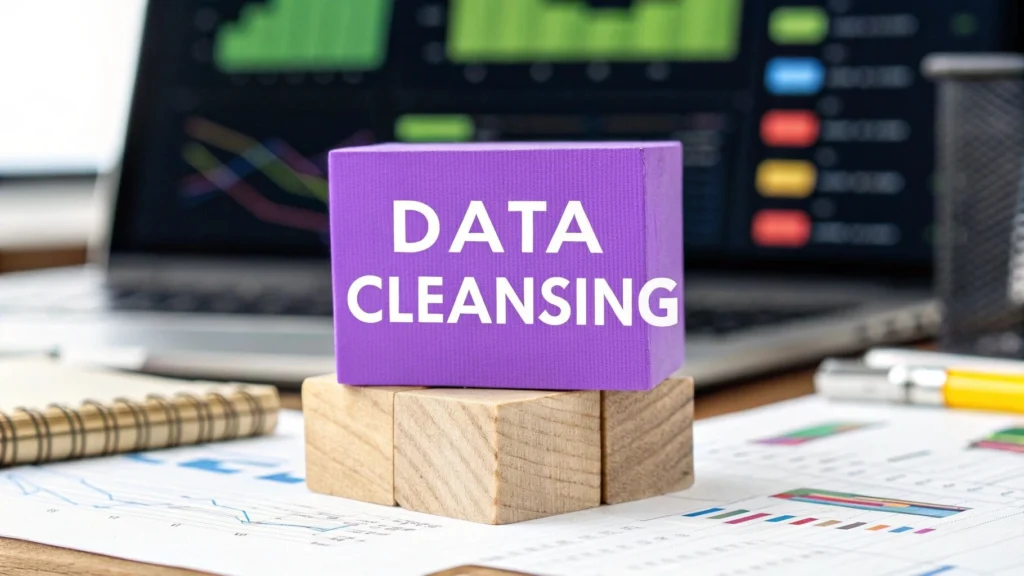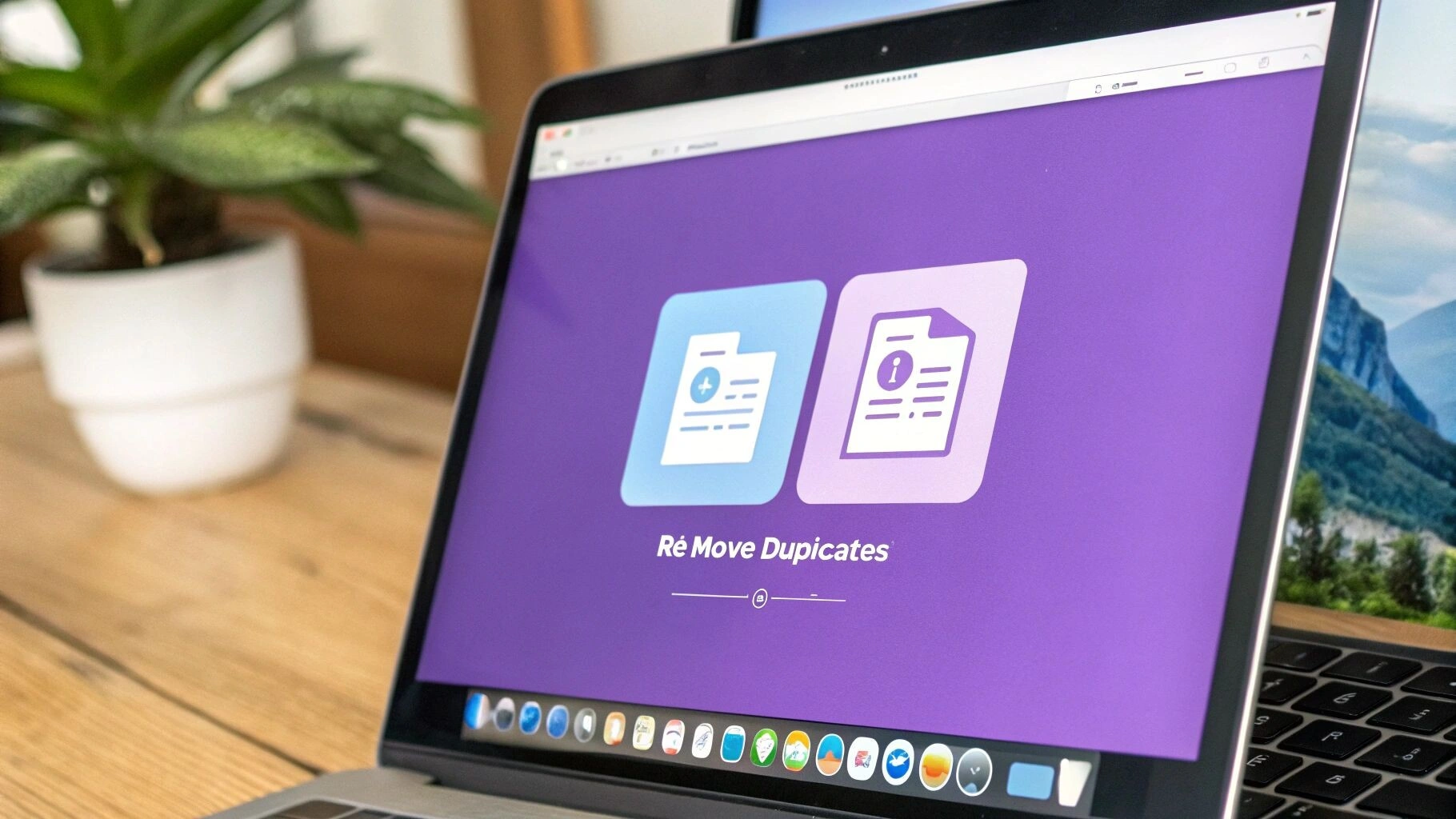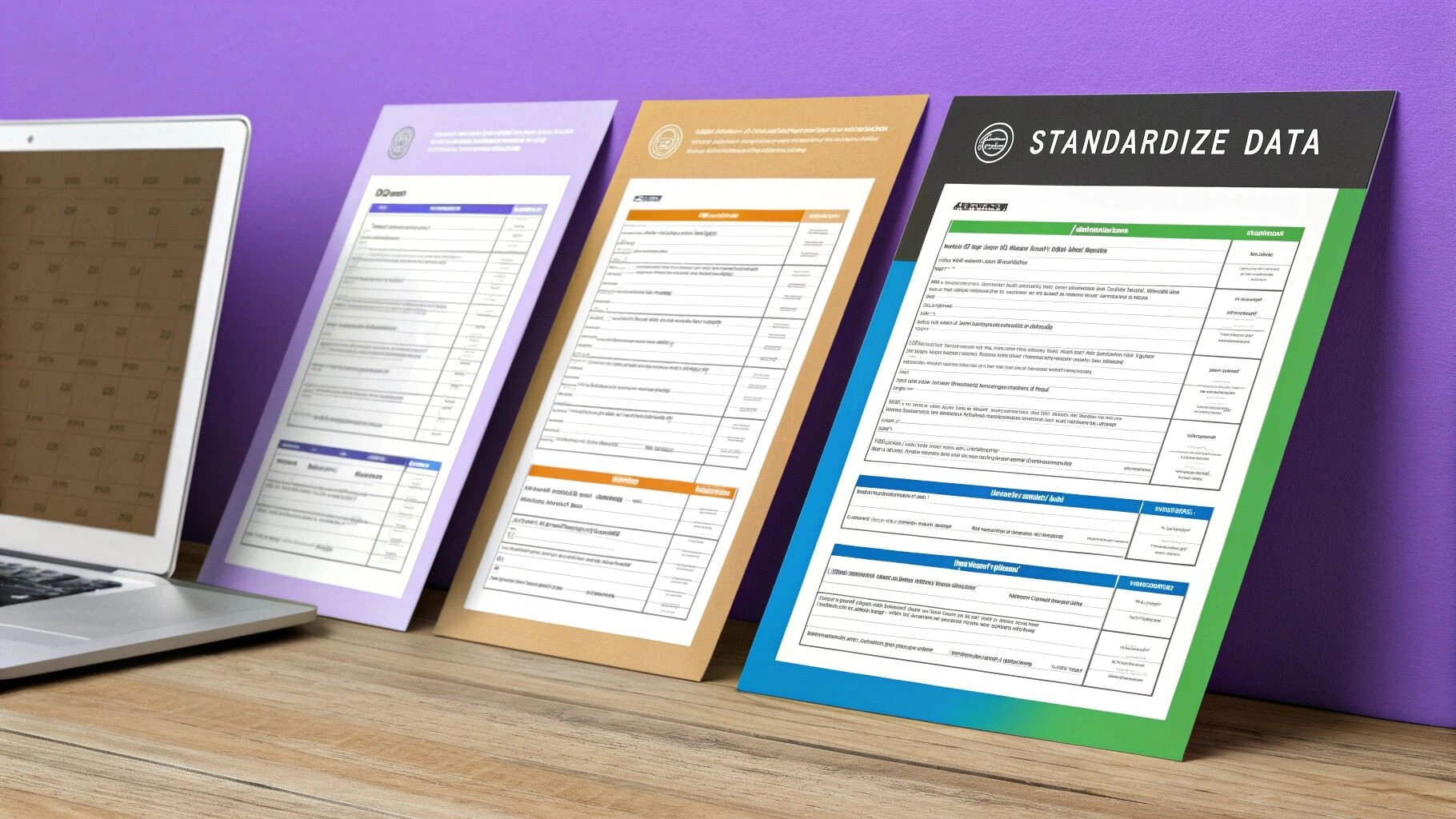8 Essential Data Cleansing Techniques for 2025
Discover 8 essential data cleansing techniques to improve data quality. Learn practical tips for deduplication, validation, and more in our 2025 guide.

The quality of your information assets dictates the quality of your business decisions. Poor data quality, plagued by duplicates, inconsistencies, and inaccuracies, can lead to flawed analytics, wasted resources, and missed opportunities. It undermines everything from marketing personalisation to financial forecasting. Mastering effective data cleansing techniques is no longer a niche IT task; it is a fundamental business imperative for any organisation aiming for operational excellence and a competitive edge.
This guide provides a comprehensive roundup of eight critical techniques, moving beyond theory to offer actionable steps and enterprise-level best practices. We will explore how to systematically identify and rectify data errors, ensuring your datasets are accurate, reliable, and ready to fuel growth. You will gain a clear understanding of:
- Data Deduplication and Duplicate Detection
- Data Standardisation and Normalisation
- Missing Data Imputation
- Outlier Detection and Treatment
- Data Validation and Constraint Checking
- Data Parsing and Transformation
- Data Profiling and Quality Assessment
- Record Linkage and Entity Resolution
For businesses looking to automate these complex processes, solutions like Osher Digital can provide the tailored automation and AI-driven frameworks needed to maintain data integrity at scale. Let’s delve into the methods that transform raw data into a reliable strategic asset.
1. Data Deduplication and Duplicate Detection
Data deduplication is a foundational data cleansing technique focused on identifying and removing redundant or duplicate records from a dataset. This process is crucial for maintaining a single source of truth, preventing skewed analytical outcomes, and reducing operational inefficiencies caused by conflicting information. It involves systematically comparing records based on one or more attributes to find exact or near-exact matches.

For instance, a marketing organisation might have multiple entries for “Jon Smith” and “Jonathan Smith” at the same company, leading to duplicated outreach efforts. Similarly, an e-commerce platform could have several listings for the same product with minor variations in the description, confusing customers and splitting sales data. Deduplication addresses this by merging these records into a single, authoritative entry.
Implementation and Best Practices
Effectively implementing data deduplication requires a structured, multi-stage approach to ensure accuracy and minimise the risk of data loss.
- Start with Exact Matches: Begin by identifying and removing records that are identical across key fields like email address, phone number, or customer ID. This is the simplest and safest form of deduplication.
- Move to Fuzzy Matching: After handling exact duplicates, employ fuzzy logic algorithms (e.g., Levenshtein distance, Jaro-Winkler) to find near-matches that may contain typos, abbreviations, or formatting differences.
- Establish a Similarity Score: Implement a scoring system to quantify the likelihood of two records being duplicates. This allows you to set a threshold for automatic merging and flag records that require manual review, increasing confidence in the process.
- Prioritise Data Backups: Always create a complete backup of your dataset before initiating any deduplication process. This provides a safety net to restore data in case of an error.
For practical applications and tools in removing redundant information, explore specific Data Deduplication Solutions that can streamline these complex tasks.
2. Data Standardization and Normalisation
Data standardisation is a systematic approach to converting data into a consistent and uniform format across a dataset. This data cleansing technique ensures that similar data elements adhere to the same conventions, units, and structures, eliminating variations that can compromise analysis and operational processes. It involves establishing and applying a clear set of rules for data representation.

For example, an organisation might receive customer data where phone numbers are recorded in multiple formats like (02) 9999 8888, 0299998888, and +61 2 9999 8888. Standardisation would convert all of these into a single format, such as +61299998888. Similarly, it can be used to convert all state abbreviations to a consistent format (e.g., “NSW” instead of “N.S.W.” or “New South Wales”) or align product names from different suppliers into a unified catalogue.
Implementation and Best Practices
Successful implementation of data standardisation hinges on a well-defined and methodical process to ensure data integrity and usability.
- Establish a Data Dictionary: Before any transformations, create a comprehensive data dictionary. This document should define each data field, its acceptable format, data type, and any specific business rules, serving as the blueprint for consistency.
- Utilise Reference Data: Employ authoritative reference data and lookup tables (e.g., ISO country codes, official postal codes) to validate and standardise fields. This anchors your data to externally verified sources, increasing its accuracy.
- Document Transformation Rules: Meticulously document every rule used for transformation. This creates a transparent and repeatable process, which is invaluable for future data governance, audits, and training new team members.
- Test on Sample Data: Always pilot your standardisation rules on a small, representative sample of your dataset. This allows you to identify any unforeseen issues or edge cases before applying the changes across the entire database, mitigating risk.
For a deeper understanding of how these rules are applied in practice, explore other essential data cleansing methods that complement standardisation.
3. Missing Data Imputation
Missing data imputation is a critical data cleansing technique that addresses gaps in datasets by estimating and filling in absent values. This process is essential for maintaining the completeness and integrity of a dataset, ensuring that missing information does not compromise analytical accuracy or the performance of machine learning models. It involves using statistical methods, algorithms, or defined business rules to infer plausible values for the empty fields.

For example, an enterprise might encounter missing age values in its customer database. Instead of discarding these valuable records, imputation can estimate the missing ages based on other demographic patterns. Similarly, in IoT applications, missing sensor readings can be imputed using time-series analysis, while missing income data in a survey can be estimated using regression models based on factors like education and job title.
Implementation and Best Practices
Choosing the right imputation strategy is crucial, as an inappropriate method can introduce bias and lead to flawed conclusions. A systematic approach ensures the imputed data remains reliable.
- Analyse Missing Data Patterns: Before selecting a method, it’s vital to understand why the data is missing. Is it Missing Completely at Random (MCAR), Missing at Random (MAR), or Missing Not at Random (MNAR)? The underlying mechanism dictates the most suitable imputation technique.
- Select an Appropriate Method: Simple methods like mean, median, or mode imputation can work for MCAR data, but more sophisticated approaches like regression imputation or k-Nearest Neighbours (k-NN) are better for MAR data. For complex scenarios, advanced tools like Python’s
scikit-learnor R’smicepackage offer powerful options. - Consider Multiple Imputation: For important analyses where uncertainty must be accounted for, use multiple imputation. This technique creates several completed datasets, runs the analysis on each, and pools the results to provide more robust and reliable estimates.
- Validate and Document: Always validate the imputation results by comparing the distribution of imputed data against the original data. Thoroughly document the chosen methods, assumptions, and rationale to ensure transparency and reproducibility in your data cleansing techniques.
4. Outlier Detection and Treatment
Outlier detection is a sophisticated data cleansing technique used to identify data points that deviate significantly from the expected pattern or distribution within a dataset. This process is vital for improving model accuracy and preventing skewed analytical results, as outliers can represent data entry mistakes, measurement errors, or genuinely rare events. It employs statistical methods, machine learning algorithms, and domain knowledge to find and handle these anomalies appropriately.

For example, a financial services company might use outlier detection to identify fraudulent transactions that fall far outside a customer’s usual spending habits. Similarly, in manufacturing, this technique can pinpoint sensor readings that indicate equipment malfunction, while in market research, it can find survey responses that are clear data entry errors, such as an age entered as “200”.
Implementation and Best Practices
Successfully implementing outlier detection and treatment requires a careful, context-aware strategy to ensure data integrity is enhanced, not compromised.
- Investigate Before Acting: Never automatically remove an outlier. Always investigate its origin to determine if it is a genuine error or a valid but exceptional data point that holds valuable business insight.
- Employ Multiple Methods: Use a combination of detection methods, such as Z-score, Interquartile Range (IQR), or machine learning models like Isolation Forest. Cross-validating results from different techniques increases confidence in identifying true anomalies.
- Consider Business Context: The definition of an outlier is highly dependent on the business context. What is an outlier in one scenario (e.g., a million-dollar purchase) may be normal in another. Tailor your detection rules accordingly.
- Choose Robust Statistical Methods: When building models, use robust statistical methods that are less sensitive to the presence of outliers. This can provide a more accurate baseline for analysis even before outliers are treated.
Organisations can leverage powerful frameworks like Apache Spark MLlib or Python’s scikit-learn to implement these advanced data cleansing techniques at scale.
5. Data Validation and Constraint Checking
Data validation is a proactive data cleansing technique that involves systematically checking data against predefined business rules, formats, and constraints. This process acts as a quality gate, ensuring that data meets required standards before it enters a system or is used in analysis. By identifying and flagging data that violates these rules, organisations can prevent inconsistencies and maintain the integrity of their datasets.
For example, a financial services company might validate that all transaction dates are in the past and not in the future. Similarly, an e-commerce platform would validate that an email address follows the standard [email protected] format or that a postal code is valid for the specified state or territory. This fundamental check prevents corrupt or illogical data from propagating through downstream systems, which is crucial for reliable reporting and operations.
Implementation and Best Practices
Implementing robust data validation requires a clear strategy that combines technical rules with business logic to ensure data is not just syntactically correct but also contextually meaningful.
- Start with Basic Checks: Begin by implementing foundational validation rules, such as checking data types (e.g., numeric, text), formats (e.g., dates, emails), and ranges (e.g., age must be between 0-150). These initial steps catch the most common errors.
- Implement Rules Incrementally: Introduce more complex business logic and cross-field validations in phases. This allows for controlled rollouts and makes troubleshooting easier. For instance, after validating a postal code’s format, you can add a rule to check that it corresponds to the selected state.
- Use a Configurable Rule Engine: Employ a flexible rule engine, like those found in tools such as Great Expectations or Talend. This allows business analysts, not just developers, to define, manage, and modify validation rules as business needs evolve without requiring code changes.
- Monitor and Report Failures: Track validation failure rates and provide clear error messages. This not only helps end-users correct data entry mistakes but also helps data stewards identify systemic issues with data sources or integration pipelines.
For a deeper dive into rule-based verification, explore these various data validation techniques to strengthen your quality framework.
6. Data Parsing and Transformation
Data parsing and transformation are crucial data cleansing techniques for converting unstructured or semi-structured data into a structured format suitable for analysis. This process involves extracting specific information from complex data types, such as log files or free-text fields, and reshaping it to align with the requirements of a target system or analytical model. It is essential for unlocking the value hidden within diverse and inconsistent data sources.
For example, a DevOps team might need to parse server log files to extract timestamps, user IDs, and specific error codes to diagnose performance issues. Similarly, a market research organisation could need to transform wide-format survey data, where each question is a column, into a long format, where each row represents a single response, to facilitate trend analysis. These transformations make raw data usable for enterprise applications.
Implementation and Best Practices
Successful data parsing and transformation depend on a precise and well-documented approach that anticipates variability in the source data.
- Utilise Regular Expressions: Employ regular expressions (regex) for pattern-based extraction from text. This is highly effective for pulling structured data like phone numbers, postcodes, or dates from unstructured comment fields.
- Test on Diverse Data Samples: Before deploying any parsing logic, test it rigorously on a wide variety of sample data. This helps identify and address edge cases, such as malformed records or unexpected formats, preventing errors in production.
- Implement Robust Error Handling: Develop a clear strategy for handling data that fails to parse correctly. This may involve logging the problematic records for manual review or routing them to an exception queue, ensuring that the entire data pipeline does not fail.
- Document All Transformation Logic: Maintain thorough documentation for every parsing rule and transformation step. This is critical for future maintenance, debugging, and ensuring other team members can understand and adapt the process.
Tools like Apache Spark DataFrames and Python’s Pandas library offer powerful capabilities for implementing these complex data wrangling tasks at scale.
7. Data Profiling and Quality Assessment
Data profiling is a foundational diagnostic technique used to systematically examine datasets and generate comprehensive statistics about their structure, content, and overall quality. Before applying other data cleansing techniques, profiling acts as a crucial first step, helping organisations understand their data’s characteristics, identify anomalies, and pinpoint specific areas that require remediation. This process uncovers the true state of your data, revealing everything from value distributions to hidden patterns.
For example, a financial institution might profile its customer data to discover that 30% of records are missing a date of birth, a critical field for compliance. Similarly, a retailer could profile its product catalogue and find that inconsistent categorisation is rampant, preventing effective product recommendations. By creating a detailed summary of the data’s health, profiling provides the roadmap for targeted cleansing efforts.
Implementation and Best Practices
A structured approach to data profiling ensures that the insights gathered are both accurate and actionable, setting the stage for effective data quality improvement.
- Start with High-Level Analysis: Begin by examining the entire dataset at a macro level to understand its basic structure, such as column counts, data types, and row numbers. This initial scan helps identify major structural problems before delving into field-specific details.
- Focus on Business-Critical Fields: Prioritise your profiling efforts on data fields that are most important to business operations, such as customer identifiers, transaction amounts, or product SKUs. This ensures you address the most impactful quality issues first.
- Utilise Automated Profiling Tools: Leverage specialised tools like Informatica Data Quality or Talend Data Preparation to automate the analysis. These platforms can efficiently generate detailed reports on null values, frequency distributions, and data patterns, saving significant manual effort.
- Establish a Monitoring Cadence: Data quality is not a one-time fix. Implement regular, scheduled profiling to continuously monitor data health, track improvements over time, and quickly detect new issues as they arise in your data pipelines.
To see how these principles are applied in practice, you can explore the capabilities of modern platforms like AWS Glue DataBrew, which integrate data profiling directly into the data preparation workflow.
8. Record Linkage and Entity Resolution
Record linkage, often used interchangeably with entity resolution, is an advanced data cleansing technique designed to identify and connect records that refer to the same real-world entity. This process operates across different datasets or even within a single, complex one. It moves beyond simple duplicate detection by employing sophisticated algorithms to resolve entities that may have significant variations in their representation, creating a unified, 360-degree view.
This technique is fundamental for organisations looking to consolidate information silos. For example, a bank could link a customer’s chequing account, credit card, and mortgage records into a single profile, even if names or addresses vary slightly. Similarly, a retailer can match product information from multiple vendor catalogues to prevent listing the same item multiple times under different SKUs, creating a cleaner customer experience.
Implementation and Best Practices
Successfully executing record linkage requires a meticulous and often iterative strategy to handle the inherent complexities of matching non-identical data.
- Use Blocking to Improve Performance: Instead of comparing every record to every other record, group records into smaller “blocks” based on a common attribute (e.g., postcode, first initial). This drastically reduces the number of comparisons needed and improves processing speed.
- Combine Deterministic and Probabilistic Matching: Start with deterministic rules (e.g., records must match exactly on a unique ID) to catch obvious links. Then, apply probabilistic models (e.g., machine learning classifiers) that calculate the probability of a match based on similarities across multiple fields.
- Implement Iterative Matching: Run the matching process in multiple passes. The first pass might use very strict criteria, and subsequent passes can use progressively looser criteria, leveraging insights gained from the initial matches to find more complex links.
- Validate with Manual Review: No algorithm is perfect. Always validate the results by manually reviewing a sample of the linked and non-linked records to fine-tune your matching thresholds and business rules.
For businesses aiming to consolidate disparate data sources, understanding these principles is a key step. You can discover more about harmonising data systems by exploring data integration best practices.
Data Cleansing Techniques Comparison Matrix
| Technique | Implementation Complexity | Resource Requirements | Expected Outcomes | Ideal Use Cases | Key Advantages |
|---|---|---|---|---|---|
| Data Deduplication and Duplicate Detection | Medium to High | Moderate to High CPU, storage | Removes duplicates, improves data accuracy | Customer databases, e-commerce, healthcare | Enhances data quality, reduces storage costs |
| Data Standardization and Normalization | Medium | Moderate | Consistent data formats, improved integration | Phone numbers, country codes, product naming | Enables accurate comparison and reporting |
| Missing Data Imputation | Medium to High | Moderate CPU for advanced methods | Completes datasets, reduces bias | Surveys, sensor data, customer demographics | Preserves dataset size, improves model accuracy |
| Outlier Detection and Treatment | High | High CPU and domain expertise | Identifies anomalies, improves model quality | Fraud detection, sensor malfunctions, network | Improves data quality, reveals unusual patterns |
| Data Validation and Constraint Checking | Medium | Low to Moderate | Prevents invalid data entry | Email validation, date checks, ranges | Ensures compliance, reduces downstream errors |
| Data Parsing and Transformation | Medium to High | Moderate to High | Converts unstructured to structured data | Log files, JSON/XML, survey data | Enables use of unstructured data, standardizes |
| Data Profiling and Quality Assessment | Medium | Moderate | Detailed data insights, quality assessment | Data audits, quality monitoring | Helps prioritize cleansing, uncovers data issues |
| Record Linkage and Entity Resolution | High | High CPU and tuning effort | Unified entity views across datasets | Cross-system customer data, master data Mgt | Improves integration, supports analytics |
Transforming Data into Your Most Valuable Asset
Navigating the complexities of enterprise data management requires more than a superficial understanding of data hygiene. The eight essential data cleansing techniques detailed in this guide, from foundational deduplication and standardisation to more advanced entity resolution and outlier treatment, form the bedrock of a robust data quality strategy. Each technique addresses a specific facet of data corruption, and when deployed in concert, they create a powerful system for refining raw, inconsistent information into a reliable, decision-grade asset.
Mastering these methods is not merely an IT exercise; it is a fundamental business imperative. Consistently clean data is the fuel for accurate business intelligence, trustworthy machine learning models, and personalised customer experiences. It eliminates the operational friction caused by erroneous records, empowers sales and marketing teams with precise targeting, and provides leadership with a clear, untainted view of organisational performance. The journey from messy data to strategic insight begins with a commitment to these core principles.
From Manual Effort to Automated Excellence
While manual and semi-automated approaches to data cleansing are crucial starting points, their limitations become apparent at an enterprise scale. The sheer volume, velocity, and variety of data in modern organisations demand a more sophisticated, sustainable solution. The true transformation occurs when these data cleansing techniques are embedded into automated workflows.
Consider the ongoing cycle of data quality management:
- Continuous Profiling: Automation allows for constant data profiling, flagging new quality issues as they arise, rather than waiting for a periodic audit.
- Dynamic Validation: New data entering your systems via APIs, web forms, or integrations can be validated, standardised, and enriched in real time, preventing “dirty” data from ever contaminating your core databases.
- Scalable Processing: Automated systems can process millions of records, applying complex parsing, imputation, and deduplication rules far more quickly and consistently than any human team.
This shift from reactive, manual clean-ups to proactive, automated governance is what separates market leaders from the rest. It moves your organisation from a state of perpetual data-debt firefighting to one where data integrity is a built-in, reliable feature of your operations. By automating the foundational work of data cleansing, you liberate your most valuable resources, your people, to focus on higher-value tasks like analysis, strategy, and innovation. The goal is to make high-quality data an organisational reflex, not a recurring project.
Ready to move beyond manual clean-ups and build a permanent foundation of data integrity? The specialists at Osher Digital design and implement tailored AI and business process automation solutions that embed these data cleansing techniques directly into your workflows. Visit Osher Digital to discover how you can automate data quality and unlock the full potential of your business information.
Jump to a section
Ready to streamline your operations?
Get in touch for a free consultation to see how we can streamline your operations and increase your productivity.